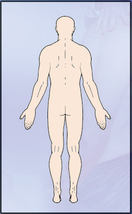CHAPTER 1 • Before beginning the physical examination, the examiner should have a working hypothesis on which to base the assessment. If you cannot make a preliminary diagnosis from the history, supplemented by observation, before you begin the examination, either you have not asked enough questions or you have not asked the right questions. • Communication and rapport are essential to gaining a patient’s trust. The patient has the right to be informed about all aspects of the examination process. Be sure to tell the patient what you are doing and to explain clearly what you want the patient to do and why it is necessary. • Unless bilateral movement is required, you should test the normal (uninvolved) side first. Testing the normal side first allows the examiner to establish a baseline for normal movement of the joint being tested. It also demonstrates to the patient what to expect, which increases the patient’s confidence and eases the patient’s apprehension when the injured side is tested. • In comparing the normal and injured limbs, you must use the same testing methods for both limbs. This means using the same initial starting position and applying the same amount of gentle force at the same point or throughout the range. You should note the position at which any changes occur. • The patient performs active movements before you perform passive movements. Passive movements are followed by resisted isometric movements. This approach gives the examiner a better idea of what the patient thinks he or she can do before the structures are fully tested. • You should perform any movements that are painful last, if possible, to prevent an overflow of painful symptoms to the next movement, which actually may be symptom free. • During active movements, if the range of motion (ROM) is full, you may apply overpressure carefully to determine the end feel of the joint. This often negates the need to do passive movements. • If active ROM is not full, you may apply overpressure but only with extreme care to prevent an exacerbation of symptoms. • You may repeat each active, passive, or resisted isometric movement several times or hold (sustain) the contraction for a certain amount of time to see whether: • This repetitive or sustained activity is especially important if the patient has complained that repetitive movement or sustained postures alter symptoms. • You should do resisted isometric movements with the joint in a neutral or resting position so that stress on the inert tissues is minimal. Any symptoms produced by the movement then are more likely to be caused by problems with contractile tissue. • For passive ROM or ligament testing, it is important that you determine not only the degree (i.e., amount) of movement, but also the quality (i.e., end feel) of the movement. • When you are testing the ligaments, apply the appropriate stress gently and repeat this several times. The stress is increased up to but not beyond the point of pain, thereby demonstrating maximum instability without causing muscle spasm. • When testing myotomes (i.e., groups of muscles supplied by a single nerve root), you should hold each contraction for a minimum of 5 seconds to see whether weakness becomes evident. Myotomal weakness takes time to develop, because the muscles are supplied by more than one nerve root. • A thorough examination often involves stressing and aggravating different tissues. At the completion of an assessment, you must warn the patient that symptoms may be exacerbated as a result of the assessment. This prevents the patient from thinking that any initial treatment may have made the condition worse, which in turn might make the patient hesitant to return for further treatment.
GENERAL PRINCIPLES AND CONCEPTS OF SELECTED MOVEMENTS AND SPECIAL TESTS

Principles of Movement Examination
 A different pattern of movement results
A different pattern of movement results
 Weakness increases or indications of possible vascular insufficiency are noted
Weakness increases or indications of possible vascular insufficiency are noted
![]()
Stay updated, free articles. Join our Telegram channel

Full access? Get Clinical Tree


GENERAL PRINCIPLES AND CONCEPTS OF SELECTED MOVEMENTS AND SPECIAL TESTS







